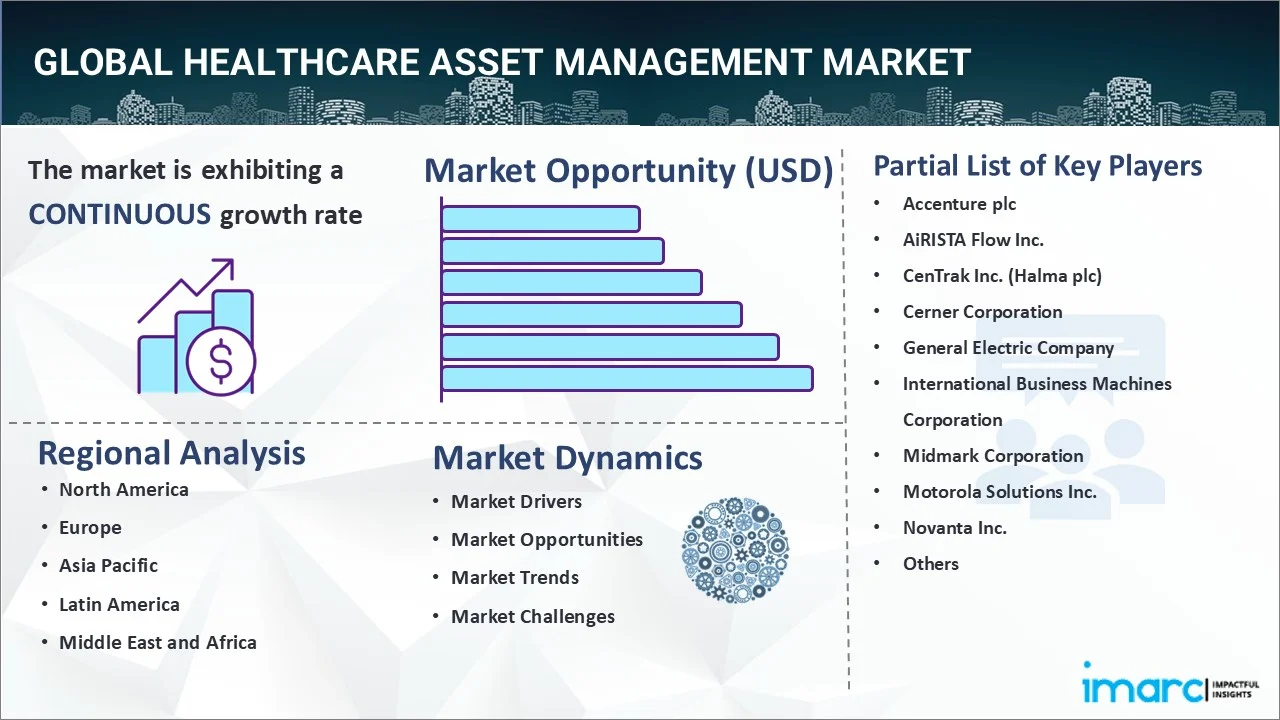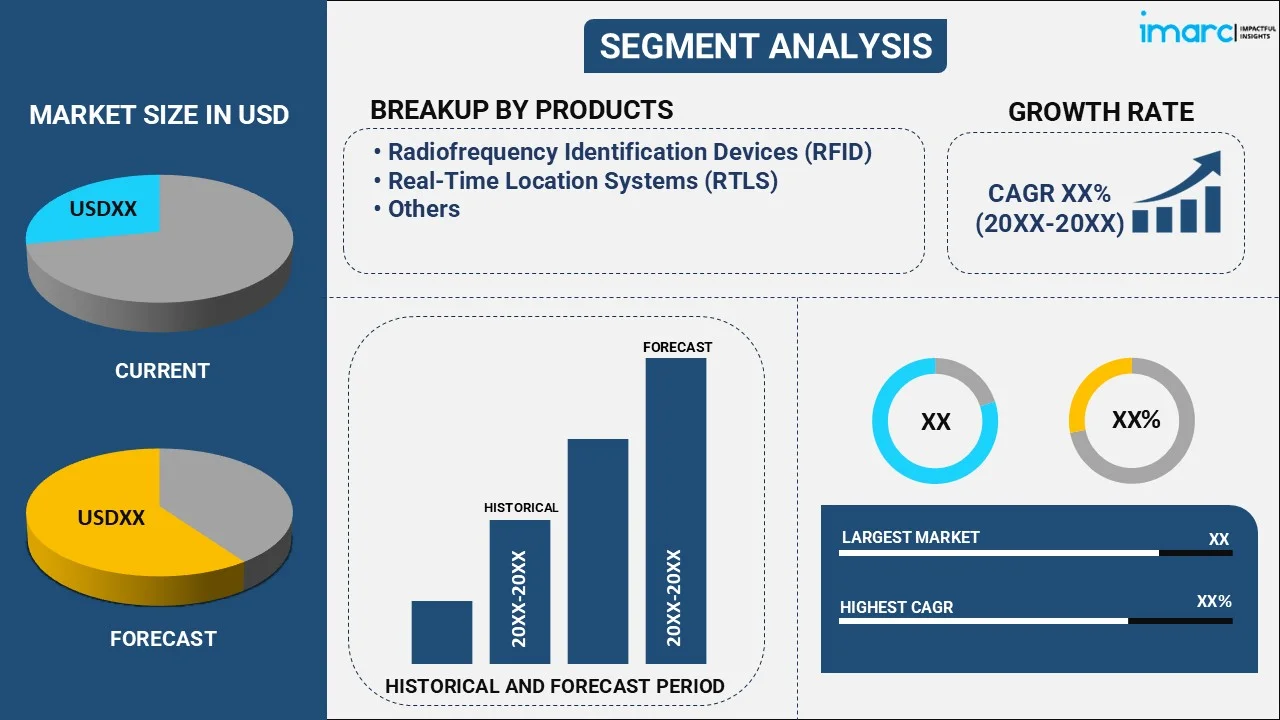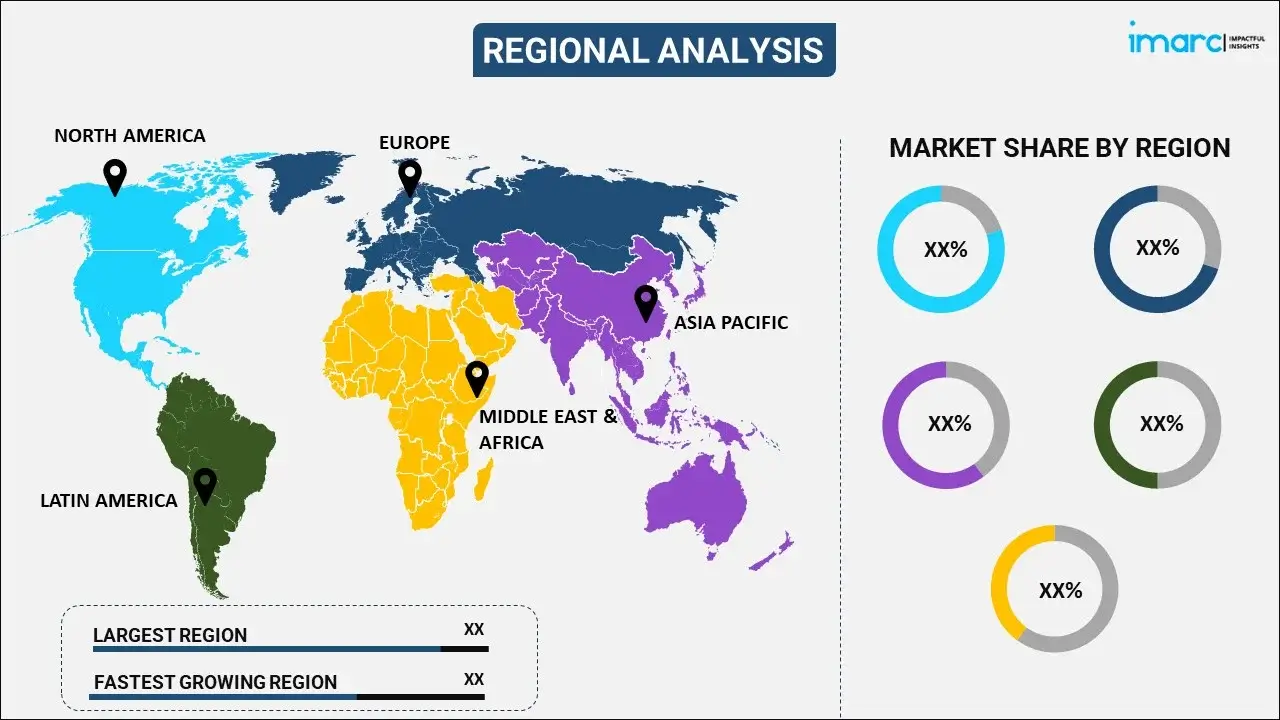
Healthcare Asset Management Market Report by Product (Radiofrequency Identification Devices (RFID), Real-Time Location Systems (RTLS), and Others), Application (Hospital Asset Management, Pharmaceutical Asset Management), End User (Hospitals and Clinics, Laboratories, Pharmaceutical Companies, and Others), and Region 2025-2033
Market Overview:
The global healthcare asset management market size reached USD 17.9 Billion in 2024. Looking forward, IMARC Group expects the market to reach USD 39.4 Billion by 2033, exhibiting a growth rate (CAGR) of 8.71% during 2025-2033. The escalating demand for effective inventory management and cost control, implementation of stringent regulations by governments and healthcare organizations to ensure patient safety, increasing prevalence of chronic diseases, technological advancements and rising healthcare expenditure are some of the major factors propelling the market.
|
Report Attribute
|
Key Statistics
|
|---|---|
|
Base Year
|
2024
|
|
Forecast Years
|
2025-2033
|
|
Historical Years
|
2019-2024
|
|
Market Size in 2024
|
USD 17.9 Billion |
|
Market Forecast in 2033
|
USD 39.4 Billion |
| Market Growth Rate 2025-2033 | 8.71% |
Healthcare asset management refers to the systematic management and tracking of assets within the healthcare industry. It involves the utilization of technology, processes, and strategies to effectively monitor and maintain medical equipment, supplies, and other physical assets. The goal is to optimize the utilization, availability, and lifespan of assets while minimizing costs and improving patient care. Healthcare asset management systems often employ various technologies such as barcoding, RFID (Radio Frequency Identification), or IoT (Internet of Things) devices to track and manage assets in real-time. This ensures accurate inventory management, reduces equipment downtime, enhances patient safety, and streamlines operational efficiency within healthcare facilities.

The increasing demand for effective inventory management and cost control in healthcare facilities is a significant driving force. Additionally, technological advancements, such as the Internet of Things (IoT) and real-time location systems (RTLS), are driving the market growth. These technologies offer enhanced asset tracking capabilities, allowing healthcare providers to locate and manage assets in real-time, streamline workflows, and improve operational efficiency. Besides this, the need for efficient healthcare supply chain management is contributing to the adoption of asset management solutions. By effectively managing and tracking assets, healthcare organizations can optimize their supply chain processes, minimize waste, reduce stockouts, and improve overall supply chain performance. Other than this, governments and healthcare organizations worldwide are increasing their spending on healthcare infrastructure, including medical equipment and devices.
Healthcare Asset Management Market Trends/Drivers:
Rising healthcare expenditure
The escalating healthcare expenditure globally is a major driver for the healthcare asset management market. Governments and healthcare organizations are investing heavily in healthcare infrastructure to meet the increasing demand for quality healthcare services. This investment includes the procurement of medical equipment, devices, and supplies. Effective asset management solutions become crucial to optimize the utilization of these assets and ensure cost-effectiveness. By implementing asset tracking systems, healthcare providers can monitor the lifecycle of assets, identify underutilized or redundant equipment, and make informed decisions regarding asset procurement and allocation.
Prevalence of chronic diseases and aging population
The rising prevalence of chronic diseases and the aging population are driving the need for healthcare asset management solutions. Chronic diseases require long-term care and specialized treatment, which involves the use of various medical devices and supplies. Asset management systems enable healthcare facilities to track and maintain these assets, ensuring their availability when needed for patient care. Additionally, the aging population requires a higher volume of medical services, leading to increased demand for medical equipment. Asset management solutions help healthcare providers effectively manage these assets, reducing downtime and optimizing their utilization, ultimately improving patient outcomes and quality of care.
Stringent regulations and standards
The implementation of stringent regulations and standards in the healthcare industry is propelling the adoption of asset management solutions. Regulatory bodies require healthcare organizations to comply with guidelines and mandates related to patient safety, data security, and asset maintenance. Asset management systems provide the necessary tools to meet these requirements by maintaining accurate records, tracking asset maintenance schedules, and ensuring compliance documentation. By utilizing these solutions, healthcare providers can demonstrate adherence to regulations, mitigate risks, and enhance patient safety. Additionally, these systems facilitate efficient audits and inspections, streamlining the regulatory compliance process for healthcare organizations.
Healthcare Asset Management Industry Segmentation:
IMARC Group provides an analysis of the key trends in each segment of the global healthcare asset management market report, along with forecasts at the global, regional and country levels from 2025-2033. Our report has categorized the market based on product, application and end user.
Breakup by Product:

- Radiofrequency Identification Devices (RFID)
- Real-Time Location Systems (RTLS)
- Others
Radiofrequency Identification Devices (RFID) is the most popular product
The report has provided a detailed breakup and analysis of the market based on the product. This includes radiofrequency identification devices (RFID), real-time location systems (RTLS), and others. According to the report, radiofrequency identification devices (RFID) represented the largest segment.
RFID devices are used to track and identify assets through radio waves. They consist of tags that can be attached to assets and readers that capture and transmit the tag information to a central system. RFID technology enables automated and real-time asset tracking, eliminating the need for manual inventory counts and reducing human errors. Healthcare facilities can easily locate and monitor assets, ensuring their availability when needed for patient care. RFID also enhances security by preventing theft and unauthorized access to sensitive equipment or supplies.
Breakup by Application:
- Hospital Asset Management
- Staff Management
- Equipment Tracking and Management
- Patient Management
- Others
- Pharmaceutical Asset Management
- Drug Anti-counterfeiting
- Supply Chain Management
Hospital asset management is the largest application segment
A detailed breakup and analysis of the market based on the application has also been provided in the report. This includes hospital asset management (staff management, equipment tracking and management, patient management, and others) and pharmaceutical asset management (drug anti-counterfeiting and supply chain management). According to the report, hospital asset management accounted for the largest market share.
In hospital asset management, healthcare asset management systems are used to effectively track and manage medical equipment, devices, and supplies within the hospital setting. These systems ensure the availability of critical assets when needed, optimize asset utilization, and streamline maintenance and servicing schedules. By accurately tracking assets, hospitals can prevent equipment loss or misplacement, reduce downtime, and enhance patient care and safety.
In pharmaceutical asset management, healthcare asset management solutions are utilized to monitor and manage pharmaceutical inventory, including medications, vaccines, and other pharmaceutical products. These systems help track expiration dates, lot numbers, and storage conditions, ensuring compliance with regulatory requirements. Pharmaceutical asset management enables accurate inventory management, reduces wastage, prevents stockouts, and ensures the availability of medications and supplies when needed, ultimately improving patient care and pharmacy operations.
Breakup by End User:
- Hospitals and Clinics
- Laboratories
- Pharmaceutical Companies
- Others
Hospitals and clinics dominate the market
The report has provided a detailed breakup and analysis of the market based on the end user. This includes hospitals and clinics, laboratories, pharmaceutical companies, and others. According to the report, hospitals and clinics represented the largest segment.
In hospitals and clinics, healthcare asset management plays a vital role in tracking and maintaining medical equipment, supplies, and other assets. It ensures efficient inventory management, reduces equipment downtime, and optimizes asset utilization. By implementing asset management systems, hospitals and clinics can improve patient care, streamline workflows, and enhance operational efficiency.
In laboratories, healthcare asset management is used to track and manage laboratory equipment, chemicals, samples, and other assets. It enables accurate inventory management, ensures compliance with regulatory standards, and enhances research and testing processes. Asset management solutions in laboratories promote efficient resource utilization, minimize waste, and support reliable experimentation and analysis.
In pharmaceutical companies, healthcare asset management is utilized to track and manage pharmaceutical inventory, including medications, vaccines, and raw materials. It enables accurate tracking of batch numbers, expiration dates, and storage conditions to ensure product quality and regulatory compliance. Asset management systems in pharmaceutical companies improve inventory control, reduce the risk of stockouts or overstocking, and enhance supply chain efficiency, ultimately contributing to the safe and effective distribution of pharmaceutical products.
Breakup by Region:

- North America
- United States
- Canada
- Asia-Pacific
- China
- Japan
- India
- South Korea
- Australia
- Indonesia
- Others
- Europe
- Germany
- France
- United Kingdom
- Italy
- Spain
- Russia
- Others
- Latin America
- Brazil
- Mexico
- Others
- Middle East and Africa
North America exhibits a clear dominance in the market
The report has also provided a comprehensive analysis of all the major regional markets, which include North America (the United States and Canada); Europe (Germany, France, the United Kingdom, Italy, Spain, Russia, and others); Asia Pacific (China, Japan, India, South Korea, Australia, Indonesia, and others); Latin America (Brazil, Mexico, and others); and the Middle East and Africa. According to the report, North America was the largest market for healthcare asset management.
The stringent regulatory environment and the focus on patient safety and compliance are major factors driving the market. Regulatory bodies, such as the FDA, in the United States enforce guidelines for equipment maintenance, calibration, and documentation, necessitating robust asset management systems. Besides this, the high healthcare expenditure and investment in advanced healthcare infrastructure contribute to market growth. The need for efficient asset utilization, inventory control, and cost optimization increases the adoption of asset management solutions. Additionally, technological advancements, such as IoT and RFID, are impelling market growth by enabling real-time asset tracking, improving operational efficiency, and enhancing patient care.
Competitive Landscape:
The key players are continuously investing in research and development to enhance their asset management solutions. They focus on developing advanced technologies, such as IoT integration, AI-driven analytics, and cloud-based platforms, to provide more comprehensive and efficient asset tracking and management capabilities. Additionally, they are forming strategic partnerships and collaborations with other technology providers, healthcare organizations, and regulatory bodies to expand their market presence and offer integrated solutions. These collaborations help in combining expertise and resources to deliver comprehensive asset management solutions tailored to the unique needs of healthcare providers. Besides this, key players are expanding their geographical footprint by entering new regional markets through mergers, acquisitions, and partnerships. This allows them to tap into the growing demand for healthcare asset management solutions in different regions and leverage their existing customer base and distribution networks.
The report has provided a comprehensive analysis of the competitive landscape in the market. Detailed profiles of all major companies have also been provided. Some of the key players in the market include:
- Accenture Plc
- AiRISTA Flow Inc.
- CenTank Inc. (Halma Plc)
- Cerner Corporation
- General Electric Company
- International Business Machines Corporation
- Midmark Corporation
- Motorola Solutions Inc.
- Novanta Inc.
- Siemens AG
- Sonitor Technologies
- Stanley Black & Decker Inc.
- Zebra Technologies Corporation
Recent Developments:
- Accenture Plc is collaborating with SAP SE on a unique joint initiative to design, develop and deliver new cloud-based capabilities that strengthen existing SAP Intelligent Asset Management solutions.
- Cerner Corporation has been acquired by Oracle. The combination of Oracle's technology and Cerner's expertise in healthcare IT aims to improve healthcare delivery, reduce administrative burden, and enhance patient outcomes.
- Midmark Corp. partnered with SignalPET to provide veterinarians with access to artificial intelligence technology for detecting pathologies on dental X-rays, improving diagnostic accuracy and treatment plans for companion animals.
Healthcare Asset Management Market Report Scope:
| Report Features | Details |
|---|---|
| Base Year of the Analysis | 2024 |
| Historical Period | 2019-2024 |
| Forecast Period | 2025-2033 |
| Units | Billion USD |
| Scope of the Report | Exploration of Historical and Forecast Trends, Industry Catalysts and Challenges, Segment-Wise Historical and Predictive Market Assessment:
|
| Products Covered | Radiofrequency Identification Devices (RFID), Real-Time Location Systems (RTLS), Others |
| Applications Covered |
|
| End Users Covered | Hospitals and Clinics, Laboratories, Pharmaceutical Companies, Others |
| Regions Covered | Asia Pacific, Europe, North America, Latin America, Middle East and Africa |
| Countries Covered | United States, Canada, Germany, France, United Kingdom, Italy, Spain, Russia, China, Japan, India, South Korea, Australia, Indonesia, Brazil, Mexico |
| Companies Covered | Accenture plc, AiRISTA Flow Inc., CenTrak Inc. (Halma plc), Cerner Corporation, General Electric Company, International Business Machines Corporation, Midmark Corporation, Motorola Solutions Inc., Novanta Inc., Siemens AG, Sonitor Technologies, Stanley Black & Decker Inc. and Zebra Technologies Corporation |
| Customization Scope | 10% Free Customization |
| Post-Sale Analyst Support | 10-12 Weeks |
| Delivery Format | PDF and Excel through Email (We can also provide the editable version of the report in PPT/Word format on special request) |
Key Benefits for Stakeholders:
- IMARC’s report offers a comprehensive quantitative analysis of various market segments, historical and current market trends, market forecasts, and dynamics of the healthcare asset management market from 2019-2033.
- The research study provides the latest information on the market drivers, challenges, and opportunities in the global healthcare asset management market.
- The study maps the leading, as well as the fastest-growing, regional markets. It further enables stakeholders to identify the key country-level markets within each region.
- Porter's five forces analysis assist stakeholders in assessing the impact of new entrants, competitive rivalry, supplier power, buyer power, and the threat of substitution. It helps stakeholders to analyze the level of competition within the healthcare asset management industry and its attractiveness.
- Competitive landscape allows stakeholders to understand their competitive environment and provides an insight into the current positions of key players in the market.
Key Questions Answered in This Report
The global healthcare asset management market was valued at USD 17.9 Billion in 2024.
We expect the global healthcare asset management market to exhibit a CAGR of 8.71% during 2025-2033.
The rising adoption of healthcare asset management, as it aids in saving time and money, locating equipment quickly, maintaining appropriate inventory stock, etc., is primarily driving the global healthcare asset management market.
The sudden outbreak of the COVID-19 pandemic has led to the growing deployment of healthcare asset management, as it eliminates the need for printouts, reduces waste, decreases repair time, etc., which in turn, combat the risk of the coronavirus infection upon human intervention.
Based on the product, the global healthcare asset management market can be segmented into Radiofrequency Identification Devices (RFID), Real-Time Location Systems (RTLS), and others. Currently, Radiofrequency Identification Devices (RFID) hold the majority of the total market share.
Based on the application, the global healthcare asset management market has been divided into hospital asset management and pharmaceutical asset management, where hospital asset management currently exhibits a clear dominance in the market.
Based on the end user, the global healthcare asset management market can be categorized into hospitals and clinics, laboratories, pharmaceutical companies, and others. Among these, hospitals and clinics account for the largest market share.
On a regional level, the market has been classified into North America, Asia-Pacific, Europe, Latin America, and Middle East and Africa, where North America currently dominates the global market.
Some of the major players in the global healthcare asset management market include Accenture plc, AiRISTA Flow Inc., CenTrak Inc. (Halma plc), Cerner Corporation, General Electric Company, International Business Machines Corporation, Midmark Corporation, Motorola Solutions Inc., Novanta Inc., Siemens AG, Sonitor Technologies, Stanley Black & Decker Inc., and Zebra Technologies Corporation.
Need more help?
- Speak to our experienced analysts for insights on the current market scenarios.
- Include additional segments and countries to customize the report as per your requirement.
- Gain an unparalleled competitive advantage in your domain by understanding how to utilize the report and positively impacting your operations and revenue.
- For further assistance, please connect with our analysts.
 Inquire Before Buying
Inquire Before Buying
 Speak to an Analyst
Speak to an Analyst
 Request Brochure
Request Brochure
 Request Customization
Request Customization




.webp)




.webp)












